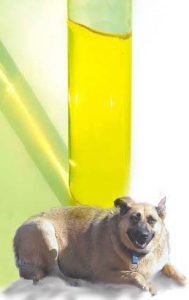Ron Hines DVM PhD
Your Pet’s Free T- 4 Level = FT4, fT4
Low thyroid issues or hypothyroidism is exceedingly rare in cats. Cats are much more likely to have overactive thyroid glands or hyperthyroidism
The free T4 (= fT4) test is a more sensitive test than the total T4 test. But it is less specific than T4 – at least for diagnosing feline hyperthyroidism. That is, using the free T4 test as an initial screening test in cats can result in more false-positives than using the total T4 test. Veterinarians generally reserve the free T4 test for pets that have other signs that make them suspicious that a pet is hyperthyroid or hypothyroid but where their total T4 test is borderline and hard to interpret (about 10-30% of hyperthyroid cats tested). Other health problems such as kidney disease can give false T4 level depression as well. (read here) Free T4 is seemingly more helpful in dogs – particularly when a case of low thyroid function (hypothyroidism) is suspected but the pet’s total T4 results were indecisive.
In the case of cats suspected of being hyperthyroid, when both total T4 and free T4 are on the high end of the lab’s reference range and the cat has other symptoms of the problem, veterinarians can be more assured of their diagnosis. A low TSH is an addition aid in confirming the diagnosis of hyperthyroidism in cats. So is a confirmatory total T4 test in 3 weeks or so. Advanced university veterinary centers can also confirm the diagnosis using thyroid scintigraphy. (read here)
Your pet’s two thyroid hormones, T3 (triiodothyronine) and T4 (thyroxine) are responsible for regulating its body metabolic rate (the amount of energy its body consumes).
Most of your pet’s thyroid hormone is attached (bound) to blood transport proteins and not available for cells to use. It is only the small amount of unbound or free T4 that is active. So measuring that, rather than the total, gives your veterinarian that information. (It is often referred to on your pet’s lab report as “T4 by equilibrium dialysis”).
Reasons Your Pet’s Free T-4 Levels Might Be Low:
It is not just hypothyroidism and hyperthyroidism that can affect your dog or cat’s thyroid hormone levels. It is quite common for any long-term health problem to lower your dog or cat’s total T4 levels. Free T4 levels are often less affected in those non-thyroid situations (although they can be a bit lower as well). Veterinarians call this the “sick euthyroid syndrome” or NTIS. It refers to the fact that any major systemic health issue or syndrome can have the ability to lower T4 levels in round about ways – not just those directly relating to your pet’s thyroid gland.
In true hypothyroidism in dogs, free T4 levels are often lower than normal before T4 and T3 levels begin to go down.
Autoimmune thyroiditis, an inherited form of hypothyroidism in dogs, will also produce low fT4 levels; so can a number of genetic abnormalities. (read here)
Sight hounds (like greyhounds) naturally have lower T4 and fT4 levels than other breeds. Just because their thyroid hormone tests are reported back as low does not mean they are hypothyroid.
Certain medications (e.g. phenobarbital read here, sulfonamides, and corticosteroids) can lower your pet’s fT4 readings.
True low T4 levels in cats are quite rare. When they do occur, it is usually in a kitten (happens in puppies too) that was born a dwarf. Read about that here. (read here & here)
Reasons Your Pet’s Free T-4 Level Might Be High:
Over 90% of the cases of high T4 (hyperthyroidism) veterinarians see are in mature-to-elderly cats. The problem is almost never seen in dogs.
Complementary Tests:
A true high Free T4 level in dogs is very rare – so recheck T4, Free T4 and TSH levels in 2-3 weeks – (earlier if the dog has obvious serious health problems or is losing weight). Low free T4 in cats is also quite rare. So repeat those tests in your cat as well. TSH stimulation test (or T3 suppression test), thyroglobulin autoantibody (=TgAA, false positive and negative tests do occur)
Check systolic blood pressure – particularly of cats. ALP and ALT levels, cholesterol and triglyceride levels in hypothyroid dogs.
It is unwise to base a diagnosis of hypothyroidism on a single blood examination. Sometimes, the best option available when thyroid test results remain hard for your veterinarian to interpret is a trial period on a moderate dose of thyroid hormone replacement.
DxMe
You are on the Vetspace animal health website
